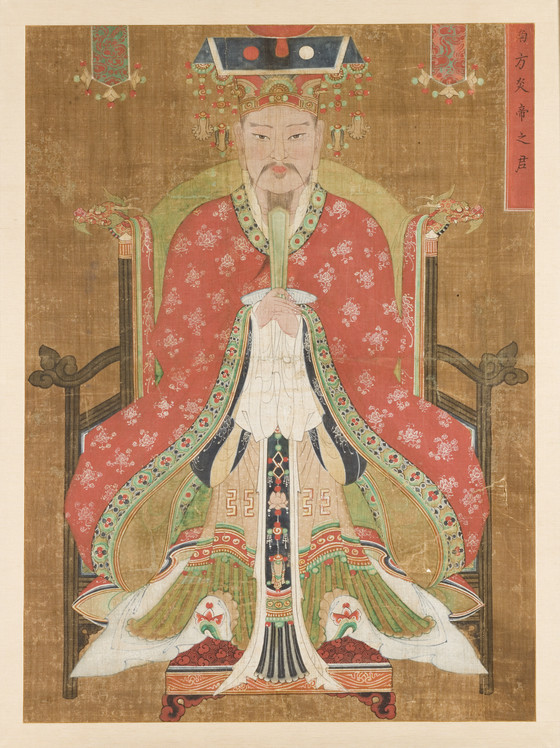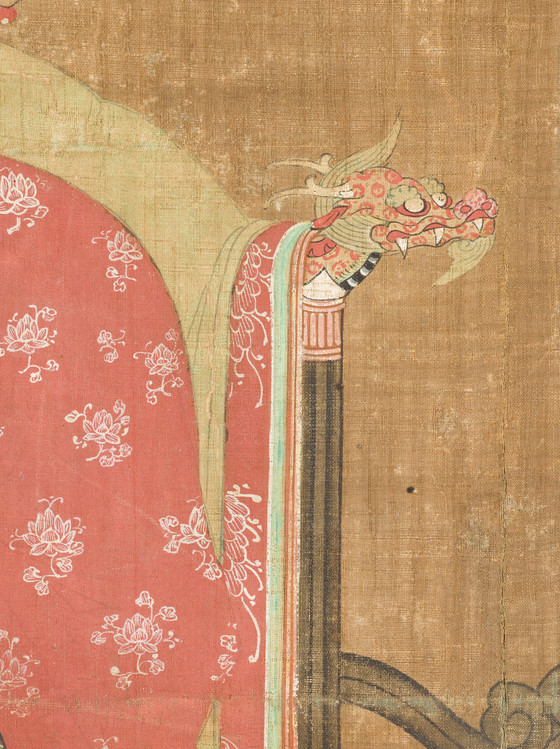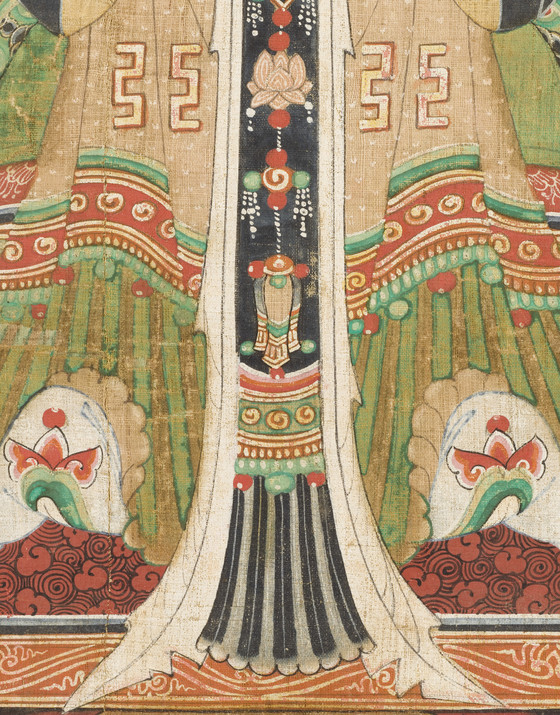Curator Notes
The name of the subject of this painting, Nambang Yeomje (Chinese: Nanfang Yendi), appears in the inscription in the upper right corner. Facing the viewer and wearing a red robe, he sits on a chair decorated with dragon heads. He holds a scepter in his hands, and the sun and moon appear on his crown. Except for the fact that he is shown seated, he very much resembles portrayals of the attendants[1] of Jeseokcheon (Sanskrit: Indra). Depictions of the Daoist personifications of the Big Dipper (Chilwon seonggun) also show them wearing hats that have sun-and-moon designs, and holding scepters. The LACMA panel is the only known painting of Nambang Yeomje with this iconography and with him shown as the sole subject matter of a single painting.
Based on the inscription and the subject matter, this painting was probably one of an original set of five. Nambang Yeomje was Lord of the Southern Quadrant; the other four paintings would have shown the lords of the north, east, and west quadrants, in addition to a central figure.[2] The five lords are differentiated only by the colors of their robes: their faces, positions, and clothing styles are the same. Intact examples of sets of these late Joseon dynasty (1800-1910) paintings exist in Gimryong Temple, South Gyeongsang province (fig. 1), and Tongdo Temple, South Gyeongsang province.
The five-color scheme used in this painting is consistent with the important color scheme of Daoist theory, the Five Elements of the Cosmos, and yin and yang. Considering the five messengers’ names, the figures are very closely related to both times and the five directions.
Nambang Yeomje can be found among the Daoist deities. According to the Chinese history Records of the Grand Historian (Shiji),[3] Yeomje Shinong, successor to the throne of Fuxi (known as the founder of ancient China), was known as a lord of medicine and pioneer of agriculture. He studied herbs to make new medicines and he taught farmers how to make the land more productive. He was also given the name Yeomje (lord of fire) because he understood the inconvenience of the dark night and created lamps to be lit everywhere from oil-bearing trees. Then he created positions for and placed the five authorities that managed fire.
The lords of the other directions also have counterparts in and represent other aspects of the Five Elements. The eastern lord rules over trees, the western lord rules over metals and heavenly punishments, and the northern lord rules the seas and winds. The center lord reigns over the world of ghosts and thunder; he also oversees the other lords. Originally, these figures were probably Daoist deities, and it is not clear when they entered the Buddhist cosmology. They might have been assimilated into Buddhism along with other Daoist deities such as mountain and kitchen gods, and the Buddhas of the Big Dipper (Chilseong Yeorae). It appears, however, that paintings of the five lords were not commonly enshrined in Buddhist temples, because there are many fewer paintings of them than of other Daoist deities.
The pigments on the panel are painted somewhat thinly spread and the colors are harmoniously arranged. Nambang Yeomje’s dignity is expressed through his gentle facial expression and his refinement is apparent in the fine details of his robe (det.1, 2). The panel was probably painted in the early eighteenth century.
Footnotes
[1] The attendants of Jeseokcheon (Sanskrit: Indra) are Ilgung Cheonja (emperor of the sun), and Wolgung Cheonja (emperor of the moon).
[2] The full complement of lords (and their typical attire) are as follows: Dongbang Taeho, Lord of the Eastern Quadrant, in a green or blue robe; Seobang Soho, Lord of the Western Quadrant, in a white robe; Nambang Yeomje, Lord of the Southern Quadrant, in a red robe; Bukbang Jeonwuk, Lord of the Northern Quadrant, in a black robe; and Jungang Hwangje, Lord of the Center, in a yellow robe. The associated messengers are Nyeonjik saja, who governs the time of the year; Woljik saja, who governs the time of the month; Iljik saja, who governs the time of day; and Shijik saja, who governs the time of the hour.
[3] The Records of the Grand Historian (Shiji), a history of China, was written by Chinese author Sima Qian (司馬遷) (145-86 BC).
Bibliography
Buddhist Cultural Properties Research Institute. Korean Buddhist Painting [Hanguk ui bulhwa], vol. 1-40. Yangsan, Korea: Buddhist Cultural Properties Research Institute, 1996-2006.
Cho, Seongje. Our Philosophy Alive in Folk [Musok e sarainneun uri sanggosa]. Seoul: Minsokwon, 2005.
Chung, Jaeseo. Origin and History of Korean Daoism [Hanguk dogyo ui giwon gwa yeoksa]. Seoul: Ehwa Women’s University Press, 2006.
Kubo, Noritada. Stories on Buddhist Gods [Dogyo ui shin gwa shinseon yiyagi]. (Trans. Jeongwhan Yi). Seoul: Ppuri wa Ipari, 2004.
Song, Hyeseung. “Studies on Paintings of Gods in the Joseon Dynasty [Joseon sidae ui shinseondo yeongu].” Master’s thesis, Ehwa Women’s University, 1988.
More...






